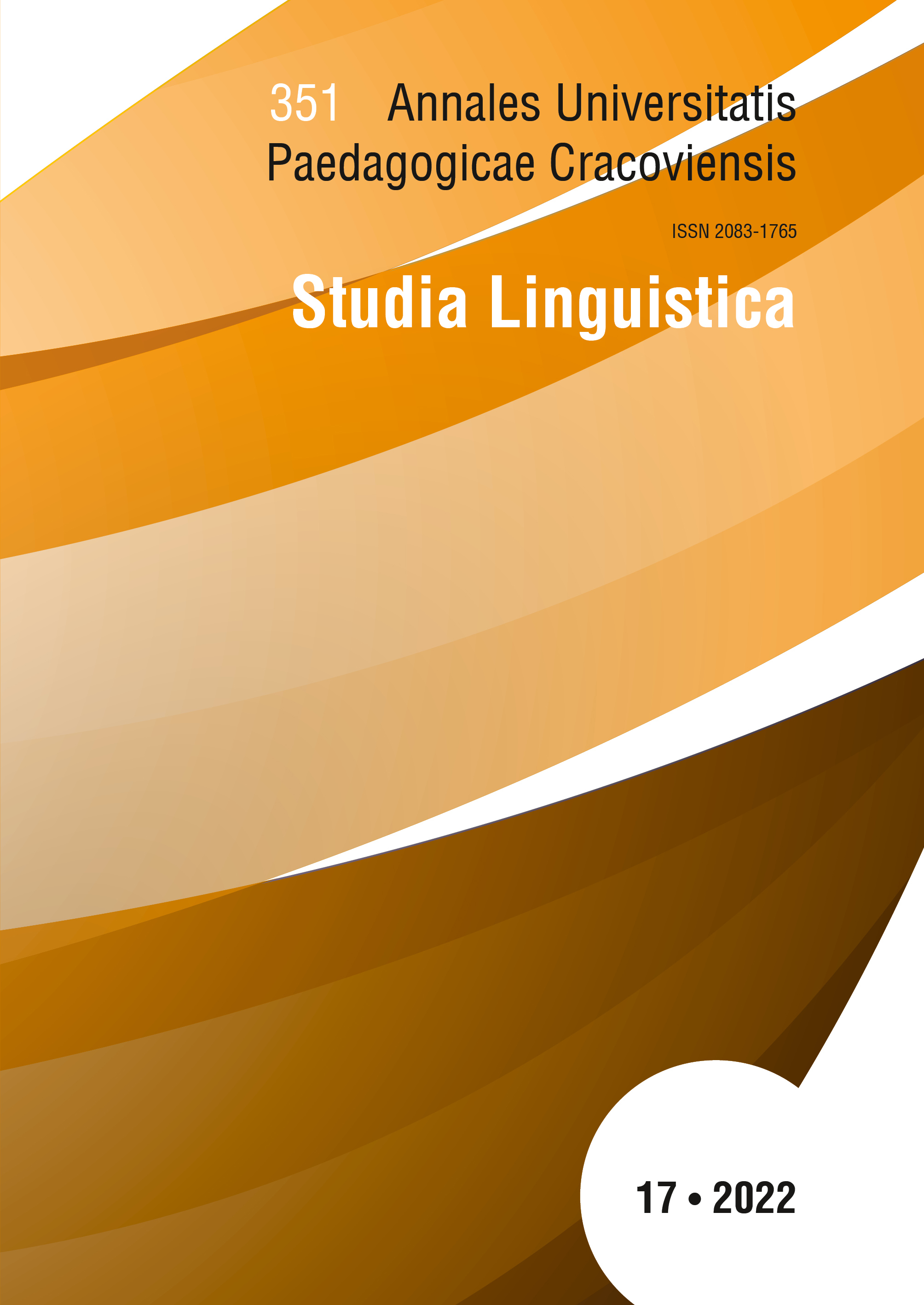Liczba trzy w kulturze i języku
Main Article Content
Abstrakt
Already in the oldest cultures, numbers were used not only for counting, but humans used them to tame and organise the world and attributed to them magical, mystical and causative powers. It is difficult to characterise all cultural and linguistic areas in which the number three plays a very important role and performs many functions. Out of necessity, this article will limit itself to selected ones: various contemporary and past religions; folk culture; sports; children’s rhymes and counting books; phraseological idioms, proverbs and maxims. Triads occur extremely often in the physical and mental world of many societies, because the number three is considered lucky, perfect, often even sacred, basic in many areas of life (among others in folklore, in fairy tales, in literature, in games and plays, spells, aphorisms, wishes).
Downloads
Article Details

Utwór dostępny jest na licencji Creative Commons Uznanie autorstwa – Użycie niekomercyjne – Bez utworów zależnych 4.0 Międzynarodowe.
Autor, zgłaszając tekst do redakcji czasopisma „Annales Universitatis Paedagogicae Cracoviensis. Studia Linguistica”, zaświadcza, iż jest on rezultatem wyłącznie jego własnej twórczości, że treść artykułu nie była dotychczas publikowana oraz że utwór nie narusza w żadnym stopniu praw autorskich ani praw pokrewnych innych osób, jak również innych praw osób trzecich, a także, że niczyje prawa do utworu (lub jego jakiejkolwiek części) nie zostały pominięte. Po podpisaniu umowy prawa majątkowe do opublikowanych materiałów zostają przeniesione na Wydawnictwo Naukowe Uniwersytetu Komisji Edukacji Narodowej w Krakowie.
Rocznik „Annales Universitatis Paedagogicae Cracoviensis. Studia Linguistica” to czasopismo o otwartym dostępie, a cała jego zawartość jest udostępniana bezpłatnie dla użytkowników i instytucji na zasadach licencji Creative Commons CC-BY-NC-ND 4.0 (uznanie autorstwa, użycie niekomercyjne, bez utworów zależnych). Na podstawie tej licencji autorzy zgadzają się, że ich prace mogą być zgodnie z prawem ponownie wykorzystywane do jakichkolwiek celów, za wyjątkiem celów komercyjnych, bez konieczności uzyskania uprzedniej zgody ze strony autora lub wydawcy. Każdy może prace te czytać, pobierać, kopiować, drukować, rozpowszechniać oraz przetwarzać, pod warunkiem poprawnego oznaczenia autorstwa oraz oryginalnego miejsca publikacji. Publikowanych tekstów nie można wykorzystywać do tworzenia utworów zależnych (np. do tłumaczenia ich i publikowania w innym języku bez zgody wydawcy). Jest to zgodne z definicją otwartego dostępu BOAI (Budapest Open Access Initiative) „Studia Linguistica”nie pobiera opłat za składanie artykułów ani ich przetwarzanie.
Autor, przesyłając artykuł do redakcji „Studia Linguistica”, bezwględnie zgadza się z poniższymi punktami:
-
Oświadczam, że jestem Autorem lub Współautorem nadesłanego tekstu. Przesłany tekst nie był nigdzie publikowany, jest całkowicie oryginalny i nie narusza w żadnym stopniu praw autorskich ani praw pokrewnych innych osób, jak również innych praw osób trzecich, a także, że niczyje prawa do utworu nie zostały pominięte.
-
Oświadczam, że nadesłany tekst nie został złożony do recenzji lub/i publikacji w innym czasopiśmie.
-
Przyjmuję do wiadomości, że Autor ponosi pełną odpowiedzialność za każdy przypadek plagiatu, niezależnie od tego, czy został on wykryty podczas procesu recenzji, czy po publikacji w „Studia Linguistica”.
-
Oświadczam, że ponoszę pełną odpowiedzialność finansową i prawną za wszelkie roszczenia związane z utworem.
-
Potwierdzam uznanie wszystkich źródeł danych wykorzystanych i cytowanych w badaniach.
-
Potwierdzam, że artykuł został wykonany z należytą starannością zgodnie ze standardami edytorskimi „Studia Linguistica”.
Bibliografia
Bąba S., Liberek J., 2002, Słownik frazeologiczny współczesnej polszczyzny, Warszawa.
Google Scholar
Forstner D., 1990, Świat symboliki chrześcijańskiej, przeł. i oprac. W. Zakrzewska, P. Pachciarek, R. Turzyński, Warszawa.
Google Scholar
https://mamatoja.pl/wyliczanki-dla-dzieci-małych-i-dużych (dostęp 10.12.2021).
Google Scholar
https://www.filmweb.pl/films/search?q=trzy (dostęp 5.01.2022).
Google Scholar
Ifrah G., 1990, Dzieje liczby, czyli historia wielkiego wynalazku, przeł. S. Hartman, Wrocław.
Google Scholar
Jędraszko C., 1980, Łacina na co dzień, wyd. 5, Warszawa.
Google Scholar
Kopaliński W., 1987, Słownik mitów i tradycji kultury, wyd. 2, Warszawa.
Google Scholar
Kopaliński W., 1990, Słownik symboli, Warszawa.
Google Scholar
Kowalski P., 2007, Kultura magiczna: omen, przesąd, znaczenie, Warszawa.
Google Scholar
Krzyżanowski J. (red.), 1972, Nowa księga przysłów i wyrażeń przysłowiowych polskich, t. 3, Warszawa.
Google Scholar
Leeuw van der G., 1997, Fenomenologia religii, przeł. J. Prokopiuk, Warszawa.
Google Scholar
Lurker M., 1994, Przesłanie symboli w mitach, kulturach i religiach, przeł. R. Wojnakowski, Kraków.
Google Scholar
Marczewska M., 2012, „Ja cię zamawiam, ja cię wypędzam…”. Choroba. Studium językowo-kulturowe, Kielce.
Google Scholar
Melech W., 1999, Sentencje, cytaty, zwroty i przysłowia łacińskie, Warszawa.
Google Scholar
Niwiński A., 1993, Bóstwa, kultury i rytuały starożytnego Egiptu, Warszawa.
Google Scholar
Pisarkowa K., 1988, Wyliczanki polskie, Wrocław.
Google Scholar
Słodowski J. (red.), 2001, Leksykon polskich filmów fabularnych, wyd. 3, Warszawa.
Google Scholar
Szczerbowski T., 1998, Gry językowe w przekładach „Ulissesa” Jamesa Joyce’a, Kraków.
Google Scholar
Tresidder J., 2001, Słownik symboli, przeł. B. Stokłosa, Warszawa.
Google Scholar
Wójtowicz M., 2012, Magiczne funkcje liczby trzy w medycynie ludowej, „Acta Humana”, nr 3, s. 111–122.
Google Scholar
Wójtowicz M., 2013, Semantyka wybranych liczb w kulturze ludowej mieszkańców wsi, „Studia Wschodniosłowiańskie”, t. 13, s. 361–374.
Google Scholar
Zieniukowa J., 1994, Liczby i słowa. Sposoby wyrażania ilości oraz ich odniesienia kulturowe, [w:] Polszczyzna a/i Polacy u schyłku XX wieku, red. K. Handke, H. Dalewska-Greń, Warszawa, s. 131–143.
Google Scholar
Zimny R., 2000, Raz, dwa, trzy – enumeracja i perswazja, „Język a Kultura”, t. 13, Wrocław, s. 215–227.
Google Scholar
Żmigrodzki P. (red.), Wielki słownik języka polskiego PAN; https://wsjp.pl/szukaj/podstawowe/wyniki?szukaj=trzy (dostęp 20.06.2022).
Google Scholar
